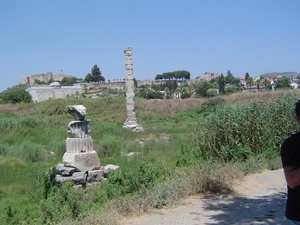Advertisement
Published: August 26th 2011

 Remnant of the Temple of Artemis
Remnant of the Temple of Artemis
Once one of the Seven Wonders of the World, now reduced to a bird perch. From this angle you can see much of the world's religions: Near left background, the Isa Bey Mosque (Islam); on the hill above that, the Church of Saint John (Christian); in the distant right, a synagogue (Judaism); and of course Artemis in the foreground.The Temple of “Artemis Ephesia” (the Ephesian Artemis), goddess of fertility, was known as one of the Seven Wonders of the World. (Can you name the others?)
Built in the 6th century BC, it was said by Plinius to have had 127 columns. It is thought to have been destroyed and reconstructed 7 times, a tribute to an enduring dedication to Artemis (and female fertility?) amongst the Anatolians. But now when you visit it, there’s just one remade column standing in a swamp, with a large white nesting bird in residence at the top of the pillar. Oh well, perhaps that is a living sign of fertility.
After Ephesus had exhibited centuries of dedication to the Goddess Artemis, it is said that Saint John brought the Virgin Mary to Ephesus and she lived out her remaining years in the vicinity. “Mary’s house” has been “rebuilt on the site”, though there is no hard evidence for this. Nonetheless, it is now a major tourist attraction. Both Pope Paul VI in 1967 and Pope John Paul II in 1979 visited Ephesus and celebrated Mass, strengthening the belief that the Virgin Mary lived and died there.
At the House of the Virgin,

 Outdoor Mass site at the House of the Virgin Mary
Outdoor Mass site at the House of the Virgin Mary
A pleasant spot for worship, no matter what your faith.it was the one time on our tours that Phil was apoplectic. “Some people will believe anything!” he grumbled, remaining outside while the long line of tourists filed through the house, knelt and prayed, lit candles, dabbled in holy water, and wrote wishes to attach to an exterior wall.
When I went inside I was instructed to put a scarf over my head (they had a stash of Madonna blue ones available for clueless people like me). It was a reminder that in my youth I would never have entered church without a hat or veil, so the requirement of wearing of a pashmina into a mosque is not so strange at all.
On the same tour we also visited the Isa Bey Mosque, and this time I was ready to cover my head and shoulders. After the Friday faithful had exited, we tourists were allowed in, and our guide removed his shoes and entered onto the carpet, from where he pointed out various features of the interior. Completed in 1375, it’s an early example of an Anatolian columned mosque. The Isa Bey Mosque also has a large enclosed courtyard.
A previous Imam was outside the mosque,

 House of the Virgin Mary
House of the Virgin Mary
The crowds file into the front door, hoping for what?offering to write anyone’s name in Arabic. I can show you mine and Phil’s sometime. We may also have been expected to buy something from his stall, in return. Despite the recurring assertion “No need to buy”, I remained confused by the accompanying pointing out of the merits of wares.
Finally, as with most of the tours, we visited a craft center. (As the previous guide had told us: They view tourism as half educational and half commercial.) This time the demonstration was about carpets. We were again treated with Turkish tea and given a talk on the various styles and makes of carpets. (Two women on our tour sighed, “This is the third time we’ve done carpets.”)
It was one of those times that I wished my father could have been alive and present. He spent a lot of his life selling and laying carpets, and I remember him remarking that little did he ever think, as he was mending horse blankets as a teenager in Goshen, that one day he would be mending oriental rugs worth more than his annual income.
Some Turkish carpets are wool, some are cotton, and the most amazing to me

 House of the Virgin Mary from the exit side
House of the Virgin Mary from the exit side
In one door and out the other. With busloads waiting, not much chance for lengthy meditations.was that some are made of silk! They’re all beautiful and made to last, but the silk ones are exquisite and actually appear to change colour as you view them from different angles. The demonstrators would lay out a carpet on the floor in front of us, and then fling it around so we saw it from the other side and listen to us exclaim in surprise.
Turkish carpet makers are also very proud of their unique double knotting system, which makes their carpets stronger.
How I would have loved to have bought a carpet! Maybe someday. And maybe I’d hang it on the wall and gaze at it, rather than walk on it.
Advertisement
Tot: 0.11s; Tpl: 0.012s; cc: 9; qc: 46; dbt: 0.0738s; 1; m:domysql w:travelblog (10.17.0.13); sld: 1;
; mem: 1.1mb

 Remnant of the Temple of Artemis
Remnant of the Temple of Artemis
 Outdoor Mass site at the House of the Virgin Mary
Outdoor Mass site at the House of the Virgin Mary
 House of the Virgin Mary
House of the Virgin Mary
 House of the Virgin Mary from the exit side
House of the Virgin Mary from the exit side



















Michelle Cavanagh
non-member comment
Silk carpets
What a pity you can't come home with a few Turkish silk carpets - ah well. M xx